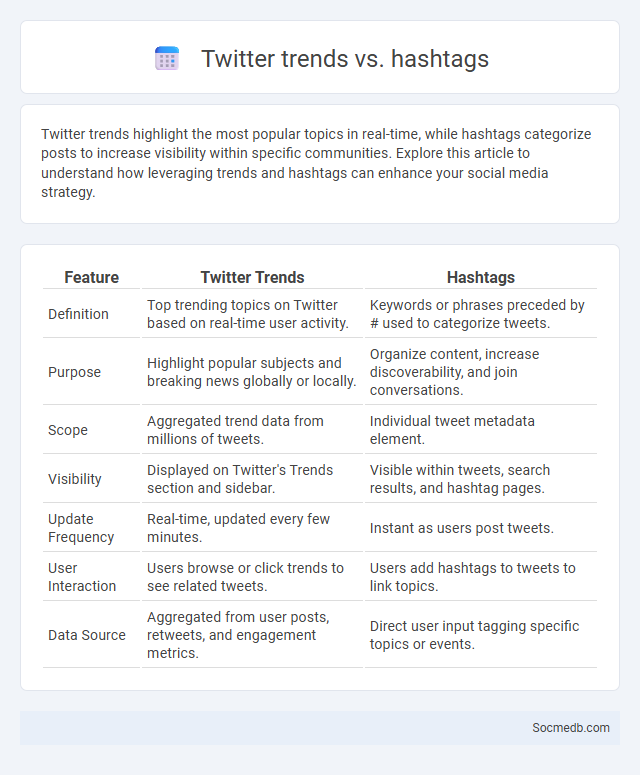
Photo illustration: Twitter trends vs hashtags
Twitter trends highlight the most popular topics in real-time, while hashtags categorize posts to increase visibility within specific communities. Explore this article to understand how leveraging trends and hashtags can enhance your social media strategy.
Table of Comparison
| Feature | Twitter Trends | Hashtags |
|---|---|---|
| Definition | Top trending topics on Twitter based on real-time user activity. | Keywords or phrases preceded by # used to categorize tweets. |
| Purpose | Highlight popular subjects and breaking news globally or locally. | Organize content, increase discoverability, and join conversations. |
| Scope | Aggregated trend data from millions of tweets. | Individual tweet metadata element. |
| Visibility | Displayed on Twitter's Trends section and sidebar. | Visible within tweets, search results, and hashtag pages. |
| Update Frequency | Real-time, updated every few minutes. | Instant as users post tweets. |
| User Interaction | Users browse or click trends to see related tweets. | Users add hashtags to tweets to link topics. |
| Data Source | Aggregated from user posts, retweets, and engagement metrics. | Direct user input tagging specific topics or events. |
Introduction to Twitter Trends, Hashtags, and Trending Algorithm
Twitter trends represent popular topics that gain widespread attention within short periods, driven by user engagement and real-time events. Hashtags act as powerful metadata tags that categorize tweets, making content discoverable and amplifying its reach across the platform. The trending algorithm analyzes factors like tweet volume, velocity, and geographic relevance to identify and display topics that are gaining rapid momentum among users.
What Are Twitter Trends?
Twitter trends represent the most popular topics and hashtags being discussed on the platform in real-time, reflecting current events, cultural moments, and viral content. These trends are algorithmically determined based on the volume and velocity of tweets related to specific keywords or hashtags within your location or globally. Understanding Twitter trends can help you engage with relevant conversations and amplify Your social media presence effectively.
Defining Hashtags on Twitter
Hashtags on Twitter serve as powerful tools for categorizing content and enhancing discoverability by linking tweets to specific topics or trends. By using the "#" symbol followed by relevant keywords, users create clickable links that aggregate conversations, facilitating real-time engagement and amplifying reach. Effective hashtag strategies leverage popular or niche tags to boost visibility, drive audience interaction, and track campaign performance across Twitter's dynamic platform.
How the Twitter Trending Algorithm Works
Twitter's trending algorithm analyzes a combination of tweet volume, velocity, and engagement across different regions to identify popular topics. It evaluates real-time spikes in conversation, factoring in your location, who you follow, and personalized interests to tailor the trends you see. Understanding how the algorithm prioritizes freshness and relevance can help you engage more effectively with your audience on the platform.
Key Differences Between Trends and Hashtags
Trends represent widespread topics or conversations gaining popularity across social media platforms, often driven by current events or viral content, while hashtags are specific keywords or phrases preceded by the # symbol used to categorize posts and increase discoverability. Trends can encompass multiple hashtags and involve broad user engagement over various subjects, whereas hashtags provide a direct way for you to join conversations and connect with niche communities. Understanding these distinctions allows you to effectively leverage social media strategies for increased visibility and targeted audience interaction.
Factors Influencing Twitter Trends
Twitter trends are primarily influenced by factors such as real-time event occurrences, hashtag popularity, and user engagement metrics including retweets, likes, and comments. The platform's algorithm also considers geographic location and language preferences to tailor trending topics relevant to specific communities. Influential accounts and viral content significantly amplify a trend's visibility, driving widespread participation and conversation.
The Role of Hashtags in Viral Conversations
Hashtags play a pivotal role in viral conversations by categorizing content and amplifying its reach across social media platforms such as Twitter, Instagram, and TikTok. By using relevant and trending hashtags, you can increase the visibility of your posts, engage a larger audience, and participate in real-time discussions. This strategic tagging helps drive organic growth and connects your content to broader, topic-specific communities.
Limitations and Controversies of Twitter’s Trending Algorithm
Twitter's trending algorithm faces limitations such as algorithmic bias, which can amplify certain topics while suppressing others, skewing public discourse. Controversies have arisen from the platform's opaque criteria for trend selection, leading to accusations of censorship and manipulation. The rapid spread of misinformation through trending topics further challenges Twitter's ability to maintain a balanced and accurate information ecosystem.
Strategies for Leveraging Trends and Hashtags
Leveraging trends and hashtags effectively boosts your social media visibility by aligning content with current audience interests and popular conversations. Analyzing trending topics through tools like Twitter Trends and Instagram Explore allows you to create timely posts that increase engagement and reach. Incorporating high-impact hashtags relevant to your niche enhances discoverability, driving organic traffic and fostering community interaction.
Future of Trends and Hashtags on Twitter
Twitter's future trends will increasingly leverage AI-driven algorithms to identify and amplify emerging hashtags in real time, enhancing user engagement and content discovery. The platform is expected to integrate more dynamic hashtag campaigns that combine multimedia and interactive elements to boost virality and brand interaction. Evolving user behavior and advanced analytics will push Twitter to optimize hashtag relevance, making them crucial tools for targeted marketing and community building.
 socmedb.com
socmedb.com